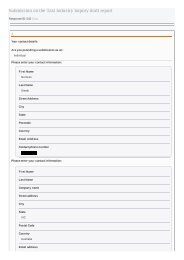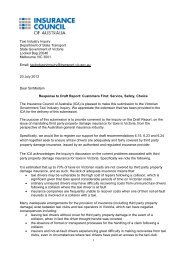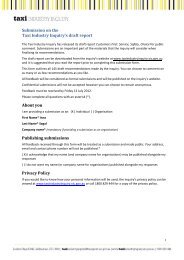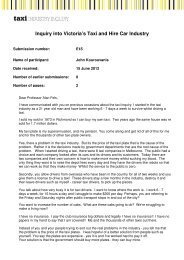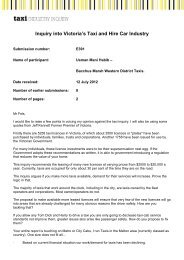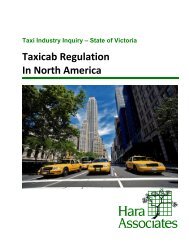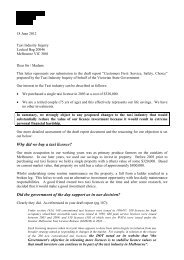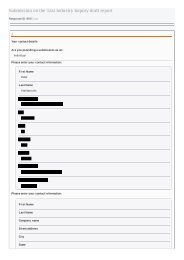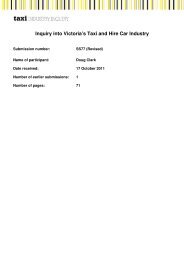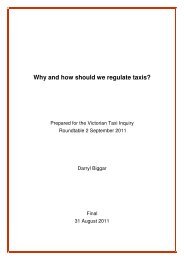Part D â Understanding and improving industry performance (PDF ...
Part D â Understanding and improving industry performance (PDF ...
Part D â Understanding and improving industry performance (PDF ...
Create successful ePaper yourself
Turn your PDF publications into a flip-book with our unique Google optimized e-Paper software.
A theme running through submissions to the inquiry, <strong>and</strong><br />
through previous work on taxi issues by relevant bodies<br />
such as the Essential Services Commission (ESC), is the<br />
pernicious effect of quantitative limits on taxi licences <strong>and</strong><br />
the associated licence values (reflecting their scarcity)<br />
that such limits create. Hire car controls are less onerous<br />
<strong>and</strong> therefore create fewer problems, but still have<br />
undesirable effects.<br />
The Department of Transport (DOT) submits that the<br />
quantitative controls on taxi licences were ‘central’ to the<br />
taxi regulatory regime in Victoria <strong>and</strong> further notes:<br />
These restrictions were introduced in the 1930s<br />
during the Great Depression. However, the shape of<br />
the <strong>industry</strong>, <strong>and</strong> the nature of the challenges it faces,<br />
have changed dramatically since the 1930s. 9<br />
In general, limits on the number of new entrants into<br />
an <strong>industry</strong> are undesirable. However, there are some<br />
circumstances in which new entry is not, on balance,<br />
beneficial for the community. The conditions under which<br />
limited entry is beneficial are very unusual (see case study).<br />
In line with its focus on exploring reform from a service<br />
perspective, the inquiry’s analysis has concentrated on<br />
whether quantitative restrictions on taxi licences have had<br />
a detrimental effect on <strong>industry</strong> <strong>performance</strong>.<br />
<strong>Underst<strong>and</strong>ing</strong> the costs <strong>and</strong> benefits<br />
of entry restrictions<br />
Free entry of firms benefits the community if the gains<br />
from entry of new firms exceed their costs. Gains<br />
generally come from the increased competition that<br />
new entry generates: lower prices, better quality,<br />
increased incentives to produce more efficiently <strong>and</strong><br />
allowing for the introduction of new <strong>and</strong> different<br />
services. The costs of entry primarily come from<br />
the duplication of fixed costs: this can mean higher<br />
average costs for the <strong>industry</strong> as a whole.<br />
The possibility that there might be ‘too much’ entry<br />
from the community’s point of view is that, while<br />
the competition due to new entrants may have<br />
some desirable effects, these entrants also ‘steal<br />
business’ from existing firms, which could result<br />
in a fall in <strong>industry</strong> productivity. The net gain from<br />
entry depends on whether the competition benefits<br />
outweigh the productivity losses. Where competition<br />
cannot generate these net gains for some reason,<br />
this is termed a market failure.<br />
Applying this analysis to taxi services, there are both<br />
costs <strong>and</strong> benefits to new entry:<br />
• The costs are the duplication of fixed costs<br />
(vehicles, insurance, network service provider<br />
fees <strong>and</strong> so on), which mean that occupancy<br />
rates of vehicles are lower than they could<br />
be even when all dem<strong>and</strong> was served.<br />
• The benefits of entry result from new dem<strong>and</strong><br />
generated by lower waiting times, competition<br />
driving fares lower or increasing incentives to be<br />
efficient <strong>and</strong> to offer innovative services.<br />
Restrictions on entry can only be justified if the<br />
evidence suggests that the gains outweigh the<br />
costs. In particular, a finding that the benefits of<br />
restricting entry outweigh the costs would require an<br />
assessment that:<br />
• More entry would not increase the number of<br />
expected trips or passenger kilometres (which<br />
would, in turn, require that entry would not<br />
lower waiting times or that consumers were not<br />
sensitive to lower waiting times)<br />
• There would be little fare competition resulting<br />
from entry<br />
• The efficiency of fleet operation would fall<br />
• There would be few new <strong>and</strong> innovative services<br />
introduced by entrants.<br />
9 DOT, Op. Cit, p.1<br />
As well as these conditions being met at any point<br />
in time, these conditions would also need to hold<br />
over time.<br />
182




